Monday, January 13th 2020

Creative at CES 2020: Super X-Fi Everything!
Creative had a positive impact on us at TechPowerUp who attended CES last year, with their retail demonstration of Super X-Fi headphone holography arguably being the most impressive product announcement at the trade show. Yours truly was especially taken aback with the hardware implementation of Super X-Fi, with the first product implementing it, the SXFI Amp, earning a well-deserved recommendation too. Naturally, we were eager to see what the company was up to next, and met them at CES this year too where it was evident they were going all aboard the Super X-Fi train, and inviting everyone along for the ride.
There were definitely a lot of hardware products with the SXFI DSP built in, but the main announcement was in the form of the new Super X-Fi Gen 2 audio profile. Gen 1, from last year, garnered a lot of positive reviews, but also had mixed reception from the general populace who had to rely on head mapping and not also the microphone-based measurements the press got in person. Indeed, my own experience with higher end headphones was not as positive, with music losing detail in favor of a surround sound speaker setup experience that perhaps was not necessary. The worse the audio source was, the worse this discrepancy was as well. Creative had gathered tens of thousands of ear profiles and feedback this past year, and used it to train their Super X-Fi AI engine to develop a more accurate, personalized audio profile as part of Super X-Fi Gen 2. The company claims this free update to all existing Gen 1 profiles will improve also the preservation of audio detail, as well as better positional accuracy as well. We will put this to the test soon enough, but read past the break on more new announcements from Creative, including all the new hardware with this technology built in.Our tour began with a live demo of Super X-Fi Gen 2 which was, as with Gen 1, extremely impressive. Indeed, there are now two more audio channels supported aside from the 7.1 before, in the form of a wide left and wide right. There is also more personalization allowed for dedicated profiles, be it for gaming or movies, which in turn have resulted in some tuned hardware shown off as well which we will see below. Lastly, Creative claims Gen 2 is more efficient in power consumption as well, with an example given of their SXFI AIR wireless headphones now gaining over 10% higher battery life than before. These are bold claims no doubt, but then they teased us with a mention of Super X-Fi Gen 3 already in the works for even more improvements, and one that we will likely see at CES 20201.Our hardware tour began with a look at the recently launched Sound Blaster X3 sound card with hardware Super X-Fi. This came out in Q4 last year, and allowed the hardware-based SXFI DSP to work with all supported headphones, along with the better Amp/DAC here compared to the SXFI Amp, as covered before. The first new-to-CES 2020 product came in the form of the Creative SXFI GAMER headset, which has a custom gaming Gen 2 profile pre-configured in the integrated SXFI DSP. This is an analogous product to their SXFI Theater wireless headphones, which is meant to target movies and the living room experience, but uses USB connectivity to power and drive the headphones, as well as the RGB LEDs surrounding the earcups. The microphone has a pop filter for noise isolation, and Creative aims to launch the SXFI GAMER in Q2 2020 for a price point under $150 (not finalized yet, but they said they were looking at a number closer to $125 at the moment).Targeting the audiophiles was a concept over-the-ears headphones using large planar magnetic drivers. Aptly called SXFI PLANAR, this was definitely the best sounding new product they had, but is also too early to really discuss more than what you see in the images above. There is an in-line smaller and lighter version of the SXFI AMP in the cable called SXFI WIRE, and Creative is seeking input from our readers on what the output connection should be, as well as the type of sound signature they should aim for. This was next to a more ready audio solution, also targeting the higher-end relative to the others, the all-new SXFI TRIO in-ear headphones with a hybrid triple driver system. These also have an in-line SXFI WIRE, and terminate in a USB Type-C connector to use with mobile devices for people on the go.Continuing their support of in-ear headphones was the new Aurvana Trio Wireless, which is a wireless neckband-style headphones with software-based Super X-Fi only. This means that the Aurava Trio Wireless will be on the compatible list in the SXFI app, but will need the SXFI Amp to make the most of it, including the DSP and playback of all audio and not just those on your device via the app. Rounding off the demo, in a whole separate room again, was the other end of the SXFI ecosystem with the SXFI CARRIER sound bar. This is not meant to replace Creative's flagship sound bar, the X-Fi SONIC CARRIER, but targets a sub-$1000 price point and offers, as you guessed by now, hardware Super X-Fi support. The SXFI CARRIER was developed in collaboration with Dolby, and has Atmos 7.1 surround sound technology combined with Super X-Fi for headphones. The soundbar itself is impressive sounding and powerful for its 34.6" length, and is paired with a 10" subwoofer that completes the 7.1 experience with 7 speakers in the soundbar and a total of 450 W output. I/O comes in the form of an HDMI eARC port, two HDMI 2.1 ports, a 3.5 mm analog jack for headphones to use Super X-Fi for when the soundbar is too loud, Bluetooth 5.0 connectivity to use with wireless headphones in general, and USB Type-C connectivity to use with some of the SXFI headphones that terminate in a Type-C connector.Creative also showed off the more budget-oriented OUTLIER ONE V2 wireless in-ear headphones for active users on the go, a prototype CLEVO laptop that integrates and SFXI DSP, a face-lifted SXFI AIR wireless headphones, as well as the recently released OUTLIER AIR and OUTLIER GOLD true wireless earbuds that boast best-in-class rated battery life on a single use cycle. We have some of these in hand for more testing, especially as a demonstration of Super X-Fi Gen 2, so look out for more on this subject coming your way.
There were definitely a lot of hardware products with the SXFI DSP built in, but the main announcement was in the form of the new Super X-Fi Gen 2 audio profile. Gen 1, from last year, garnered a lot of positive reviews, but also had mixed reception from the general populace who had to rely on head mapping and not also the microphone-based measurements the press got in person. Indeed, my own experience with higher end headphones was not as positive, with music losing detail in favor of a surround sound speaker setup experience that perhaps was not necessary. The worse the audio source was, the worse this discrepancy was as well. Creative had gathered tens of thousands of ear profiles and feedback this past year, and used it to train their Super X-Fi AI engine to develop a more accurate, personalized audio profile as part of Super X-Fi Gen 2. The company claims this free update to all existing Gen 1 profiles will improve also the preservation of audio detail, as well as better positional accuracy as well. We will put this to the test soon enough, but read past the break on more new announcements from Creative, including all the new hardware with this technology built in.Our tour began with a live demo of Super X-Fi Gen 2 which was, as with Gen 1, extremely impressive. Indeed, there are now two more audio channels supported aside from the 7.1 before, in the form of a wide left and wide right. There is also more personalization allowed for dedicated profiles, be it for gaming or movies, which in turn have resulted in some tuned hardware shown off as well which we will see below. Lastly, Creative claims Gen 2 is more efficient in power consumption as well, with an example given of their SXFI AIR wireless headphones now gaining over 10% higher battery life than before. These are bold claims no doubt, but then they teased us with a mention of Super X-Fi Gen 3 already in the works for even more improvements, and one that we will likely see at CES 20201.Our hardware tour began with a look at the recently launched Sound Blaster X3 sound card with hardware Super X-Fi. This came out in Q4 last year, and allowed the hardware-based SXFI DSP to work with all supported headphones, along with the better Amp/DAC here compared to the SXFI Amp, as covered before. The first new-to-CES 2020 product came in the form of the Creative SXFI GAMER headset, which has a custom gaming Gen 2 profile pre-configured in the integrated SXFI DSP. This is an analogous product to their SXFI Theater wireless headphones, which is meant to target movies and the living room experience, but uses USB connectivity to power and drive the headphones, as well as the RGB LEDs surrounding the earcups. The microphone has a pop filter for noise isolation, and Creative aims to launch the SXFI GAMER in Q2 2020 for a price point under $150 (not finalized yet, but they said they were looking at a number closer to $125 at the moment).Targeting the audiophiles was a concept over-the-ears headphones using large planar magnetic drivers. Aptly called SXFI PLANAR, this was definitely the best sounding new product they had, but is also too early to really discuss more than what you see in the images above. There is an in-line smaller and lighter version of the SXFI AMP in the cable called SXFI WIRE, and Creative is seeking input from our readers on what the output connection should be, as well as the type of sound signature they should aim for. This was next to a more ready audio solution, also targeting the higher-end relative to the others, the all-new SXFI TRIO in-ear headphones with a hybrid triple driver system. These also have an in-line SXFI WIRE, and terminate in a USB Type-C connector to use with mobile devices for people on the go.Continuing their support of in-ear headphones was the new Aurvana Trio Wireless, which is a wireless neckband-style headphones with software-based Super X-Fi only. This means that the Aurava Trio Wireless will be on the compatible list in the SXFI app, but will need the SXFI Amp to make the most of it, including the DSP and playback of all audio and not just those on your device via the app. Rounding off the demo, in a whole separate room again, was the other end of the SXFI ecosystem with the SXFI CARRIER sound bar. This is not meant to replace Creative's flagship sound bar, the X-Fi SONIC CARRIER, but targets a sub-$1000 price point and offers, as you guessed by now, hardware Super X-Fi support. The SXFI CARRIER was developed in collaboration with Dolby, and has Atmos 7.1 surround sound technology combined with Super X-Fi for headphones. The soundbar itself is impressive sounding and powerful for its 34.6" length, and is paired with a 10" subwoofer that completes the 7.1 experience with 7 speakers in the soundbar and a total of 450 W output. I/O comes in the form of an HDMI eARC port, two HDMI 2.1 ports, a 3.5 mm analog jack for headphones to use Super X-Fi for when the soundbar is too loud, Bluetooth 5.0 connectivity to use with wireless headphones in general, and USB Type-C connectivity to use with some of the SXFI headphones that terminate in a Type-C connector.Creative also showed off the more budget-oriented OUTLIER ONE V2 wireless in-ear headphones for active users on the go, a prototype CLEVO laptop that integrates and SFXI DSP, a face-lifted SXFI AIR wireless headphones, as well as the recently released OUTLIER AIR and OUTLIER GOLD true wireless earbuds that boast best-in-class rated battery life on a single use cycle. We have some of these in hand for more testing, especially as a demonstration of Super X-Fi Gen 2, so look out for more on this subject coming your way.

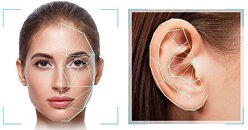
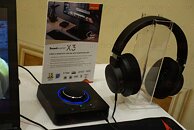
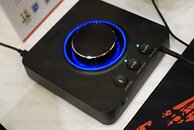
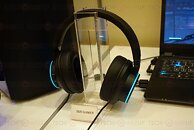
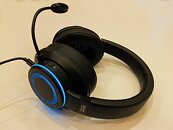
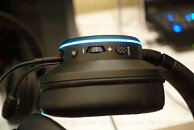
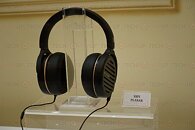
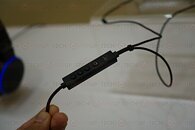
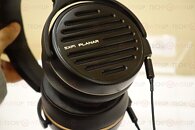
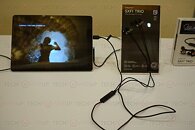
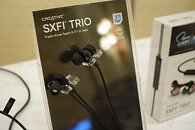
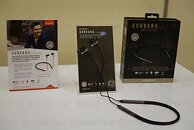
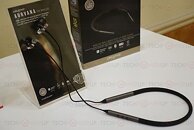
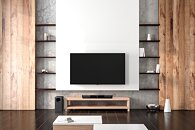
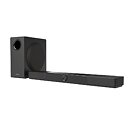
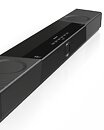
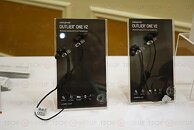
37 Comments on Creative at CES 2020: Super X-Fi Everything!
The E5 was not so good and this newer X3 was also not very impressive, especially since you have to use an app for it to get the same of your ears to get proper HRTF working. But both did drive my 6XX (300Ω) well.
And about audiences, what I see is primarily: those unaware of or incapable of understanding surround sound and the rest. Seriously, the things "buy a DAC or a receiver" people say, are simply appalling. Revealing an absolute and total misunderstanding of the subject. I can give you examples if you want.Which one of the reasons I said "Sound cards don't pick up noise like that".No, I never said it's acceptable in the Audigy SE (the X-Fi didn't have any noticeable noise and believe me, I tried hard to hear it). Then, as I said, it doesn't seem to be interference but rather a defective sound card (but I never compared it with another Audigy SE). I "fix" it turning my headphones pot at around half and turing the Audigy volume up. That way the noise is barely audible. It's weird (and not good). Also, sometimes it produces a faint whistle of different frequencies each time, which I stop by playing something.Messed up. Was the HDD defective or what? With what device?
Digital has its own problems too.
And yeah, cost is another of the big cons of DACs and receivers. It's simply unjustifiable to spend what they cost (at least those Fiio and Schiit) for what they do when sound cards (from Creative at least) do more and deliver way more than enough audio quality, unless you have some particular headphones that sound better with those (or a particular taste).
BUT, if one has the money and want to use it for music or other strictly stereo sources (even movies and games IF they already have the necessary and properly processed multichannel to stereo sound) and have some special picky headphones, then great. Even I would buy one on that case but only if I already have an AE5/7/9 or other similarly good useful PC-proper audio device for all PC usage.
I have a B350 Tomahawk that supports the Nahimic 2+ thing. Sounds good and the virtualization seems good enough but as you can't configure stereo headphones at driver and 5.1/7.1 in Windows, ends up being mostly useless. Which is why I had to kept using my Audigy SE...that, and the very low volume...
I really miss the A3D and EAX 5.0 APIs for realistic game sounds, not this emulated garbage in headsets.
Out of curiosity, is there still a market for hardware acceleration in sound cards?
When the AE5 came out. Guys like Prima.Vera were at full eeeh...activity...throwing all their..."opinions" (not informed and certainly not smart ones). So I made a comment in a Creative's Youtube video suggesting them to do an educational video about the differences between their products and onboard audio. Some Creative dude responded me saying it was a good idea an that they were actually working on that.
They never did anything, as far as I know.
It's really needed. And I mean from the basics on what audition is and how it works in real life. It's evidently greatly needed.
But remembering the times of the X-Fi especially up to now...yeah, Creative isn't precisely a company that cares to inform and explain properly anything about their sound cards. At the times of the Z brand cards they tried, very unsuccessfully.
Creative software support is abysmal, most of the headphones are trash, speakers are a subpar joke aimed at 10yo Fortnite players, their headphone surround has not made a decent progress for at least 5 years.
I wonder if they ever release something better than X7, I will probably buy it ... and regret it as usual
That's why I have my 5.1 speaker setup. Yes, I want a sound card that can smartly create a 5.1 sound environment for poorly sound coded games (99.5% of them), using an actual 5.1 physical setup not just for the stereo headsets. If there's any sound card in the market that can do that, I would be more than happy to update my X-Fi Titanium to a new one ;)
You'd think that would be more useful for games, since you don't care that much about sound quality, but if you upmix from 2 to 6 channels, you still don't get the positional accuracy.
So what I'm trying to say is that, ymmv.
So, they can output proper 5.1 or 7.1 (or other probably) multichannel audio, but they can not downmix it properly in stereo creating a virtual surround for stereo headphones or speakers. It's like multichannel sound is the default (or both are bad).
So, how do you expect to "smartly create a 5.1 sound environment"? From what? Because virtual surround in stereo is precisely the problem. And there is not another path...
Then, the video you gave is an old binaural recording, can't remember where that was from and what method was used (and can't listen to it now). But if it's binaural alone, it has the BIG problem of being really bad with sounds that come from the front while most virtual surround engines are very good at it. If it was holophonics, the one invented by Argentine Hugo Zuccarelli , well, that's (probably, or is according by my listenings) another story.
And you say you have an X-Fi, it has CMSS3D. Have you even tested it? It doesn't have the sound quality, that's for sure, but technologies like it are still being developed (I assume they depend on an expected use of hardware and method of achieving the desired result), but it does have the hability to make a virtual surround, better than the binaural as it can also put sound in front. There are a lot of demos in youtube. Here's one from the HeSuVi thing which simulates many systems. This, using discrete cards, and loook at his channel, you have other similar tests there.
And then you mention "in real time" (!!). Again you have an X-Fi, look at that for yourself. They do it in real time or fast enough as to call it "real time"...